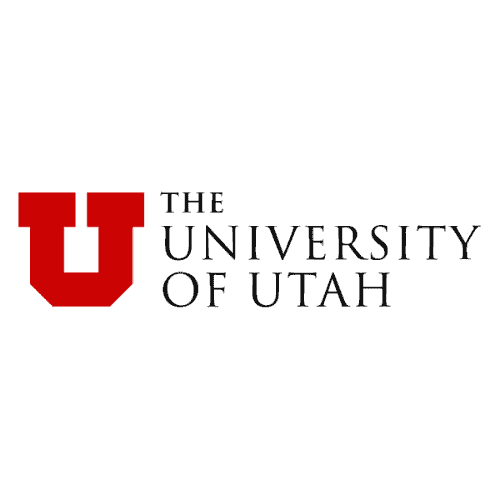Introduction
The Great Salt Lake has been shrinking at an alarming rate. Just in the past decade, the lake has declined 11 feet, reaching a record low in 2022. Experts believe that, while the task will be challenging, the decline can be reversed—but only with significant increases in water inflows to the lake. Without these increases, the lake will continue to dry up, potentially triggering widespread ecological, economic, and health consequences for the region.
In response, the State of Utah has launched an ambitious mission—its own water policy moonshot—to restore the lake. It has created new offices and task forces, reformed water laws, and committed substantial funding for lake restoration efforts. The primary mechanism in these strategies is voluntary water leasing, whereby farmers and other water rights holders are paid to reduce water consumption or leave water instream to help replenish the lake. This approach has support from a broad group of stakeholders, including conservation groups, the Utah Farm Bureau, and researchers.
Yet despite broad buy-in, political support, and available funding, voluntary water leasing has been slow to take off. A complex array of legal, hydrological, and technical challenges makes it difficult to execute leases and ensure that leased water reaches the lake. In addition, farmers—who own rights to use most of the water upstream of the lake—have at times expressed reservations about transferring water out of the region’s agricultural communities, even on a temporary or seasonal basis.
This report explores challenges and opportunities associated with water leasing for Great Salt Lake restoration. It highlights key factors that decision makers must address to encourage progress and ensure leasing programs can effectively increase flows to the lake. In the process, it demonstrates the potential impact of these leasing efforts—restoring not only a lake but safeguarding a future for the region.
The Great Salt Lake has lost roughly 22 feet in water level since the mid-1980s.
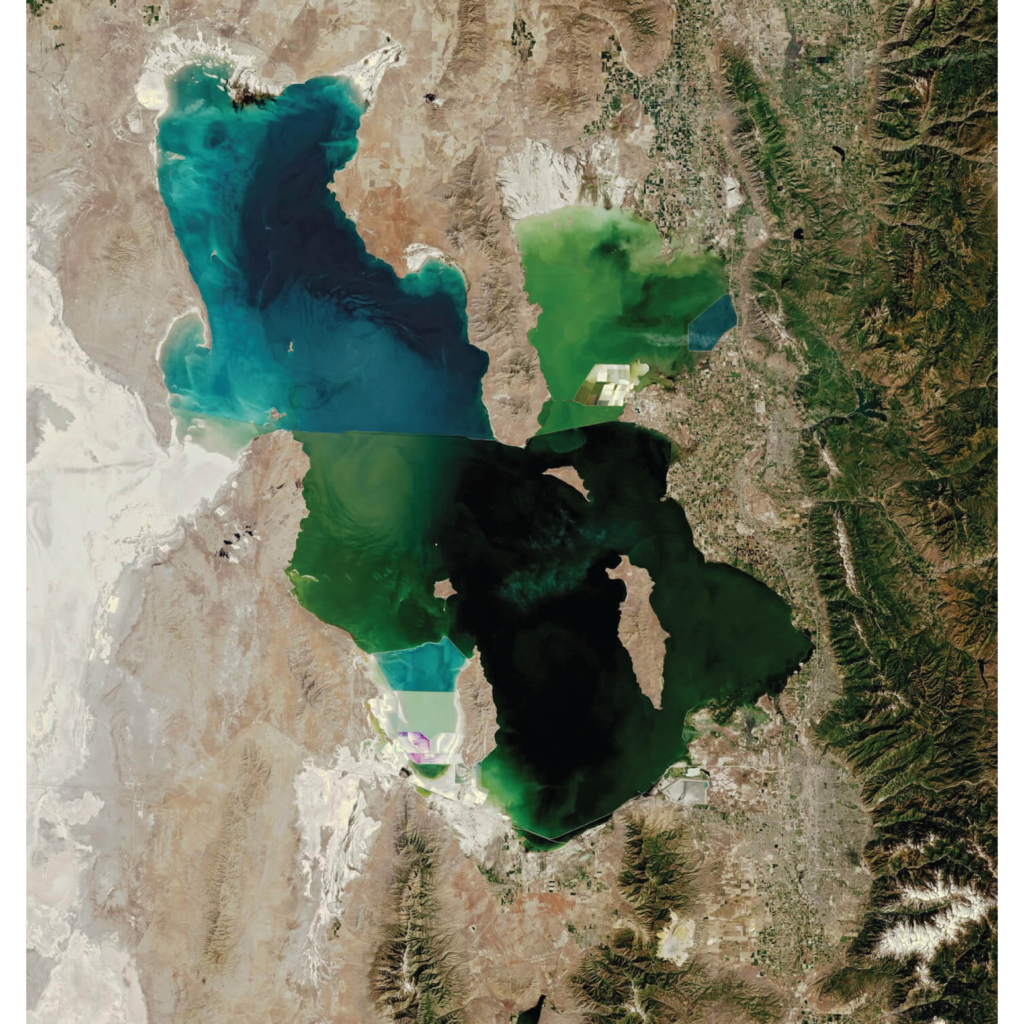
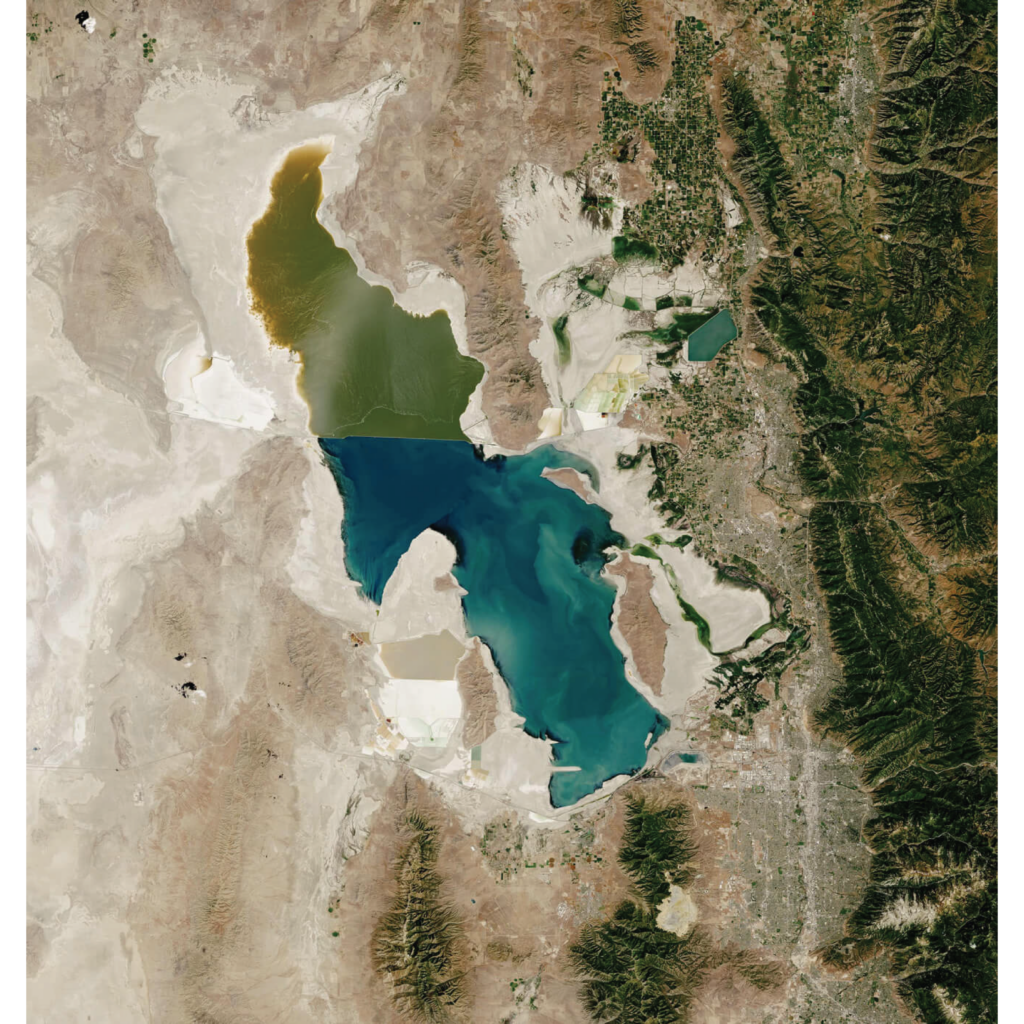
A Lake in Decline
Saline lakes, such as the Great Salt Lake, are unique hydrological systems. Unlike freshwater lakes, saline lakes are terminal, meaning they have no natural outlets. Water that flows into the lake has no escape other than through evaporation. As the water evaporates, it leaves behind salt and minerals that have accumulated from the lake’s inflows, causing terminal lakes to be much saltier than other lakes. This creates unique ecosystems that are specially adapted to these conditions but are also highly sensitive to changes in water inflows.
While a variety of factors have contributed to the Great Salt Lake’s decline—including drought, climate variability, and population growth—the biggest contributor is water diverted for agricultural use. Over 70 percent of water diversions in Utah are used for agriculture, often for growing water-intensive crops such as alfalfa.1Anderegg, et al. 2025. “Great Salt Lake Data Insights and Summary.” https://d36oiwf74r1rap.cloudfront.net/wp-content/uploads/2025/01/GSL-Jan2025.pdf These diversions have significantly reduced inflows to the lake. One recent study, for example, found that 85 percent of the lake’s area loss can be attributed to irrigated agriculture.2Wine, Michael L., Sarah E. Null, R. Justin DeRose, and Wayne A. Wurtsbaugh. 2019. “Climatization—Negligent Attribution of Great Salt Lake Desiccation: A Comment on Meng.” Climate 7(5): 67. doi:10.3390/cli7050067 Overall, the lake has lost 60 percent of its total surface area (see Figure 1). To restore the lake to a healthy level, the State of Utah estimates that additional inflows of between 471,000 acre-feet to 1 million acre-feet will be needed each year.3Steed, Brian. 2023. “The Great Salt Lake Strategic Plan.”
Figure 1
The Shrinking Great Salt Lake
The Great Salt Lake has lost 60 percent of its total surface area. Each color represents a significant change in the lake’s perimeter, with the deepest blue representing the largest it has been and the beige showing its current, smallest boundary.
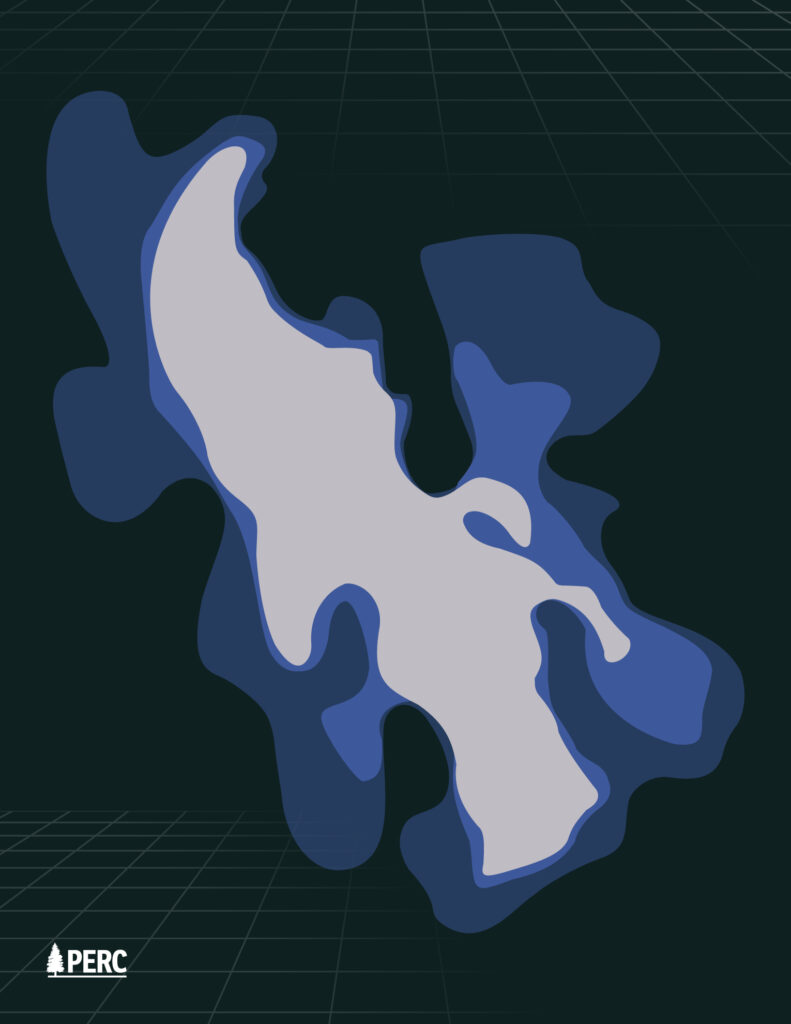
The consequences of the lake’s decline are potentially severe. Saline lakes are among the most efficient ecosystems at recycling nutrients, supporting abundant food sources for wildlife. The Great Salt Lake provides crucial habitat for over 200 bird species, including storks, herons, pelicans, and gulls, all of which feed on phytoplankton and brine shrimp in the lake. Yet if salinity levels get too high, the ecosystem could reach a tipping point and become too harsh for wildlife to survive.
Public health risks are another serious concern. As the lake shrinks, the exposed lakebed releases toxic dust that contains lead, arsenic, and cadmium. When high winds blow across the dry lakebed, they can carry these hazardous particles into the air, where they pose health risks to millions of residents in and around Salt Lake City. Dust mitigation strategies can help but are often prohibitively expensive and not entirely effective, leaving communities vulnerable to respiratory illnesses and other health complications, including higher rates of infant mortality.4Heft-Neal, Sam, Jennifer Burney, Eran Bendavid, Kara K. Voss, and Marshall Burke. 2020. “Dust Pollution from the Sahara and African Infant Mortality.” Nature Sustainability 3(10): 863–71. doi:10.1038/s41893-020-0562-1.
The decline of the Great Salt Lake could also have significant economic consequences, both locally and globally. The lake generates nearly $2 billion in annual economic value through mineral extraction, brine shrimp harvesting, and other uses.5According to Smith et al. (2010), 2.9 billion people rely on fish to make up 15 percent of their protein consumption. Smith, Martin D., Cathy A. Roheim, Larry B. Crowder, Benjamin S. Halpern, Mary Turnipseed, James L. Anderson, Frank Asche, et al. 2010. “Sustainability and Global Seafood.” Science 327(5967): 784–86. doi:10.1126/science.1185345. Brown, Hailey. “The Shrimp at the Center of World Hunger.” https://chass.usu.edu/international-studies/aggies-go/news/greatsaltlake-brineshrimp (October 2, 2024); Leger, Philippe. 1999. “The Artemia Crisis – and Solutions – Responsible Seafood Advocate.” Global Seafood Alliance. https://www.globalseafood.org/advocate/the-artemia-crisis-and-solutions/ (October 2, 2024). Companies extract vast quantities of salt and potassium sulfate from the lake, which are crucial inputs for industries worldwide. The lake supplies 40 percent of the global brine shrimp market, linking the Great Salt Lake to seafood production and agriculture worldwide.6Penrod, Emma. 2023. “‘If the Great Salt Lake Went Away, the World Would Be Poorer for It’: How Utah’s Terminal Lake Helps Feed the World.” The Salt Lake Tribune. https://www.sltrib.com/news/environment/2023/12/08/if-great-salt-lake-went-away-world/ (September 5, 2024). But as lake levels drop, these industries face operational challenges, threatening the livelihoods they support.
There are also potential consequences to Utah’s recreation and tourism industries. The shrinking lake has indirect but substantial effects on the skiing industry, which remains a key economic driver for Utah. Dust from the exposed lakebed settles on snow in the nearby Wasatch Mountains, reducing the snow’s reflective capacity and speeding snowmelt. As a result, ski seasons at popular resorts like Alta may be shortened. Meanwhile, the lake itself draws thousands of visitors for boating, sailing, waterfowl hunting, and hiking. While these recreational activities are difficult to quantify in economic terms, they are important amenities provided by the Great Salt Lake.7“Industry & Recreation.” Great Salt Lake. https://greatsaltlake.utah.gov/industry-recreation (October 2, 2024).
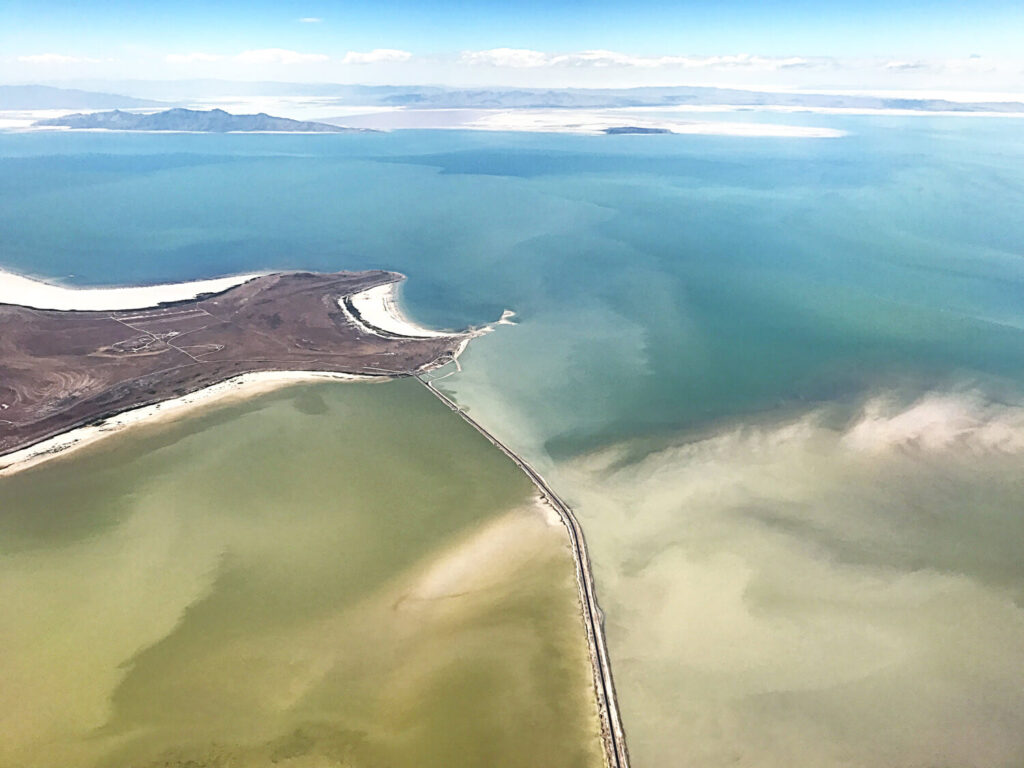
The Opportunity for Water Leasing
At its core, restoring the Great Salt Lake will require finding creative ways to increase the amount of water flowing into the lake. This means boosting inflows from the lake’s three main tributaries—the Bear, Weber, and Jordan Rivers—which collectively supply the majority of the lake’s water. Given the dominant role that agriculture plays in water use in the Great Salt Lake Basin, this effort will necessarily involve working collaboratively with farmers who control a significant portion of the basin’s water rights.
Utah has taken a number of steps to encourage voluntary solutions that work collaboratively with the agricultural community. The state has overhauled several of its water laws to discourage waste and reduce barriers to leasing water for environmental flows (see Box 1). Utah’s water rights system is governed by the prior appropriation doctrine, often summarized as “first in time, first in right.” This legal framework prioritizes older (senior) water rights over newer (junior) ones and requires water to be put to “beneficial use,” historically defined as irrigation or municipal uses. Traditionally, a rights holder who did not put all of their allotted water toward such uses could risk forfeiting a portion of their allotment. Such “use it or lose it” rules often discouraged water conservation, as farmers had no incentive to leave water in streams or adopt more efficient irrigation methods.
Recent legislative changes have modernized this system, making it more flexible and conservation oriented. Key reforms have expanded the definition of “beneficial use” to include environmental flows, allowing rights to be dedicated to restoring the Great Salt Lake. The state has also amended its “saved water” statute to protect conserved water from being classified as waste, thereby eliminating the “use it or lose it” penalty. Now, farmers who adopt efficient irrigation practices can conserve water without risking the forfeiture of their rights. Additionally, Utah has authorized split-season leasing, which allows farmers to lease water for part of the growing season. This arrangement provides flexibility for farmers to continue farming while also contributing to lake restoration efforts.
The state has also made substantial financial investments to promote water-saving practices among farmers. The legislature has committed over $200 million to agricultural optimization projects, encouraging farmers to adopt advanced irrigation technologies such as drip systems that could reduce water use. Additionally, the state created the Great Salt Lake Watershed Enhancement Trust, funded with $40 million to offer farmers compensation for leasing water in ways that benefit the lake. In 2023, the state also established a new Office of the Great Salt Lake Water Commissioner to develop a strategic plan to restore the lake and coordinate efforts across agencies to support lake restoration.
Together, these efforts represent a massive, concerted effort to restore the Great Salt Lake while working cooperatively with water users, particularly farmers (see Box 2). Farmers control the majority of water rights in the basin, which means that any efforts to restore the lake must include them. Voluntary market mechanisms, such as water leasing, create an opportunity to work collaboratively and cooperatively with these rights holders and find win-win solutions. Alfalfa farming in particular offers some flexibility for conservation efforts partly due to its water-intensive nature. Because alfalfa is cut multiple times throughout the growing season, it lends itself to options like split-season leasing, where farmers could forgo a cutting in exchange for compensation. The crop can also withstand periods of reduced irrigation without severe long-term impacts, allowing for water-saving practices like partial-season irrigation. These opportunities exemplify how thoughtful water management can balance agricultural productivity with the urgent need to restore the Great Salt Lake.
Box 1
Key Legislative Changes in Utah Water Law
Utah’s recent legislative reforms have transformed the way water can be managed for environmental purposes, making voluntary leasing a feasible option for restoring the Great Salt Lake. Here are some of the key changes:
box 2
Understanding Water Use in the Great Salt Lake Basin
The Bear, Jordan, and Weber Rivers supply water to farms and cities, to mining operations, and for various other industrial activities. The majority of water used from these rivers is for agriculture, illustrating the immense potential for partnerships with farmers to restore the Great Salt Lake. As of 2023, approximately 418,000 acres of farmland were actively irrigated in the Great Salt Lake Basin.8Estimated with data from the Water Related Land Use files, available from Utah Division of Water Resources. Utah Division of Water Resources. “Utah Water Related Land Use.” https://gis.utah.gov/products/sgid/planning/water-related-land-use/ (August 5, 2024). Farms in Utah primarily grow alfalfa, which is particularly water-intensive, requiring about three to five acre-feet of water per acre. On average, Utah has grown more alfalfa each year since 1950.9Statistics generated for alfalfa, acres harvested, through NASS quick stats. National Agricultural Statistics Service (NASS). (2024). Quick stats. United States Department of Agriculture. Retrieved September 18, 2024, from https://quickstats.nass.usda.gov/results/41E36562-70ED-3658-BEF2-98E4C1BFA864.
The large number of acreage devoted to alfalfa highlights the potential to conserve water through leasing in the basin. By choosing to switch to a less water-intensive crop, change irrigation practices, or forgo marginal cuttings of alfalfa, farmers could generate water savings that earn them lease payments. These payments would simultaneously cover their forgone agricultural revenue and help restore lake levels.
Beyond alfalfa, additional water savings could be generated by reducing mining operations or partnering with cities to reduce water use. While these two sectors make up significantly less of the total water used in the basin, they could still play a crucial role in bolstering lake levels.
The Obstacles to Water Leasing
Although there is unprecedented legal and financial opportunity for water leasing to help refill the Great Salt Lake, there are a number of obstacles that limit leasing. Indeed, despite the legislative reforms in recent years and the state’s focus on voluntary transfers, few leases have occurred to date. Many of the obstacles to leasing boil down to two fundamental challenges: quantifying water savings on the farm and then ensuring that water leased from a rights holder actually makes it to the lake.
In practice, both scenarios can be challenging. First, if a farmer decides to fallow their land, the resulting water savings depend heavily on their irrigation practices before fallowing. Similarly, switching from alfalfa to corn poses a comparable issue; without establishing a baseline of water use prior to the change, estimating the resulting water savings becomes little more than an educated guess.
Second, even if on-farm water savings can be measured and leased for lake restoration, that leased water must make its way through a labyrinth of rivers and dams, past other diverters, and to the lake. This pursuit of ensuring water reaches the lake is often called “shepherding.” Just as a shepherd guides his sheep from pasture to water, protecting his flock from dangers, guiding it around obstacles, and ensuring that no one is left behind, so too must water lessees ensure that leased water makes it to the Great Salt Lake. The term rightly captures the complexity of legal, hydrological, technical, and social barriers facing water transfers. This section describes the key challenges related to quantifying on-farm water savings and shepherding leased water to the lake.
Figure 2
Elements of Water Use
Water use is often described in terms of diversion, consumptive use, and return flow. Diversion refers to the amount of water removed from a river, stream, or canal. Consumptive use is the amount of diverted water that does not return to the water system because it is applied to a field and then either absorbed by crops or the soil or evaporates. Return flow describes the amount of water that is diverted and applied but then flows back into the stream.
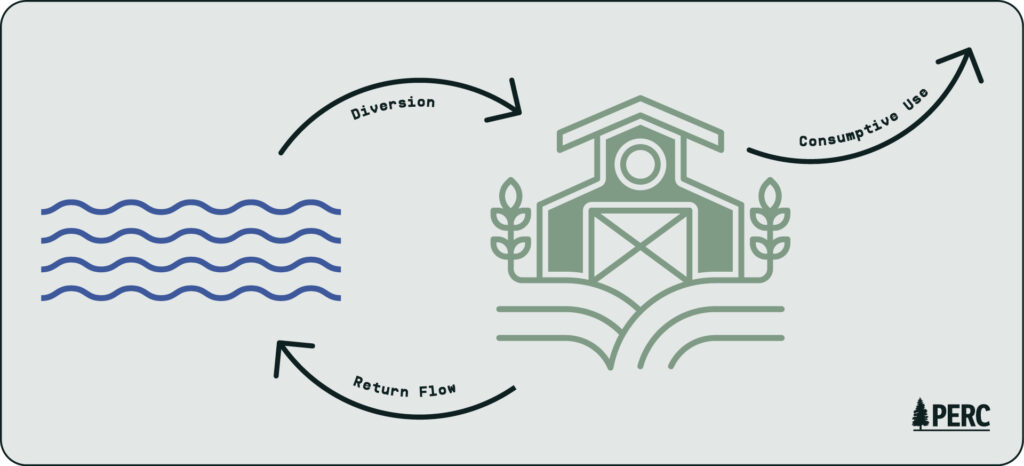
Measurement and Monitoring Challenges
Accurately measuring and monitoring water use is critical to ensuring the success of water leasing programs. This, however, is easier said than done. Water rights are often legally defined in terms of diversion, but in practice, consumptive use and return flow are also important (see Figure 2). Each presents unique measurement and monitoring challenges.
- Diversion refers to the total amount of water a farmer diverts from a river, stream, or canal. The maximum volume a farmer is authorized to divert is often called “paper water,” while the actual amount diverted in a given year is known as “wet water.” These amounts can vary based on factors like seasonal water availability, diversion infrastructure, environmental conditions, and the farmer’s specific water needs.
- Consumptive use (depletion) is the portion of diverted water that is actually consumed and does not flow back into the water system. This includes water that evaporates or is absorbed by crops. Estimating consumptive use has historically been difficult because it varies based on crop type, irrigation method, and environmental conditions.
- Return flow is the portion of diverted water that eventually makes its way back into the water system, either by seeping into groundwater or flowing back into streams. This water is important because, even though it is initially diverted by one user, once it returns to the system, it is often relied upon by downstream users to meet their own water needs. Water that ultimately makes its way to the Great Salt Lake is either water that was never diverted in the first place or diverted water that reenters the system through return flow.
The complexity of measuring these components creates uncertainty for both farmers and water managers and is the source of the first obstacle to leasing: quantifying on-farm savings. For example, if a farmer adopts more efficient irrigation practices, the reduction in consumptive use must be accurately quantified to determine how much water is saved and can be leased for conservation purposes. Traditional methods of measuring water use are often insufficient or outdated. New technologies, like satellite-based evapotranspiration (ET) monitoring, can provide more accurate estimates of consumptive use, but these technologies are still being integrated into state water management systems.
Monitoring water transfers is equally challenging and contributes to shepherding challenges. Once water is saved and leased, it must be shepherded through a labyrinth of ditches, canals, and rivers to ensure it reaches the Great Salt Lake. Any losses along the way—due to seepage, evaporation, or downstream diversions—can reduce the effectiveness of the leasing program (see Figure 3). Ensuring that leased water is protected and delivered as intended requires a robust system of monitoring and enforcement, which adds administrative and technical complexity.
Another critical consideration is whether leased water provides an actual increase in inflows to the Great Salt Lake, a concept referred to as “additionality.” In simple terms, a lease is considered beneficial when the water being leased would not have otherwise made it to the lake. If a lease is not additional, it means that the leased water would have reached the lake regardless.10Even non-additional leases can have value because the water could potentially be diverted in the future.. For example, if a water rights holder is not consuming their entire allotment, some of their water may be contributing to current lake levels through return flow. While this water is less valuable, as a lease for it would not be additional, there is still some value in protecting that water from future, legal use. This is why accurate monitoring of diversions and consumptive use is crucial. Without reliable measurement systems, it becomes more likely that funds will be spent on leases that do not necessarily increase the lake’s inflows, potentially reducing the overall effectiveness of water leasing programs.
figure3
Water Leasing Under Prior Appropriation
Prior appropriation allocates water through time, not space. Think of it like a champagne tower: The top glass represents the most senior water right, and each lower tier represents more junior rights. Champagne (water) gets poured into the top glass first, and only once it overflows does it reach the next level. But under prior appropriation, the most senior right gets satisfied first, no matter where the rights are located.
This system makes leasing water rights complex, especially when a lease affects return flows or the timing of water availability. If a glass is temporarily removed, for example, the flow pattern for other glasses changes, potentially leaving some dry. In this way, leasing a water right can reduce return flows that other junior users rely on, leading to objections. The key challenge isn’t just temporarily shifting the place or use of a right; it’s ensuring that all other rights in the system remain unimpaired while still allowing water to be leased for other purposes, including Great Salt Lake restoration.
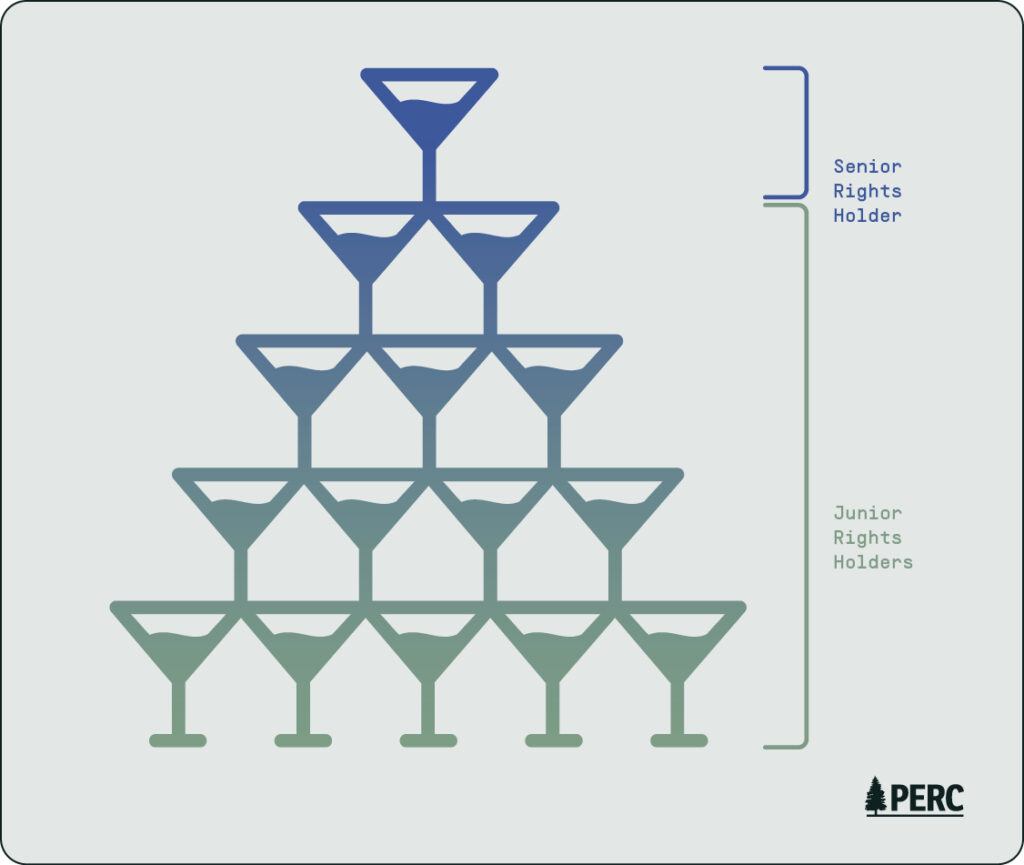
Technical and Data Gaps
The success of water leasing programs also depends on having reliable data and the technical infrastructure to support informed decision-making. Currently, there are significant gaps in the availability and accuracy of water-use data in the Great Salt Lake Basin. Many water rights are based on “paper water”; however, the actual “wet water” available in any given year can be far less, depending on hydrological conditions.
Baseline measurements of consumptive use are often lacking, making it difficult to assess the potential water savings from agricultural optimization projects or other changes in water use. Without accurate data, it is challenging to design fair and effective leasing agreements. For instance, a farmer may be open to participating in a split-season lease, but such an agreement requires precise estimates of how much water could actually be saved. Similarly, a farmer might implement more efficient irrigation methods, yet the true impact on water savings remains uncertain if, for example, increased irrigation efficiency leads to higher consumptive use.11Frederiksen, Harald Dixen, and Richard Glen Allen. 2011. “A Common Basis for Analysis, Evaluation and Comparison of Offstream Water Uses.” Water International 36(3): 266–82. doi:10.1080/02508060.2011.580449; Grafton, R. Q., J. Williams, C. J. Perry, F. Molle, C. Ringler, P. Steduto, B. Udall, et al. 2018. “The Paradox of Irrigation Efficiency.” Science 361(6404): 748–50. doi:10.1126/science.aat9314. Advanced technologies, such as remote sensing, could help fill these data gaps, but widespread implementation will require significant consideration and collaboration.
Another critical data gap relates to the interconnectedness of water rights. Water in the Great Salt Lake Basin is highly interconnected, with diversions and return flows affecting multiple users across different parts of the watershed. Understanding these connections is essential for evaluating the impact of water transfers and ensuring that they do not inadvertently harm other users. Water models that account for these connections are still in development and require continuous updates and validation to remain effective.
Figure 4
Existing Measurement Infrastructure Gaps
This map, inspired by Lukens et al. (2024), shows the existing gaps in measurement and monitoring in the Great Salt Lake Basin. Based on their analysis, they identified locations where measurement could be improved (gap) and where current methods were sufficient (no gap) to help with shepherding, along with other diverse objectives.
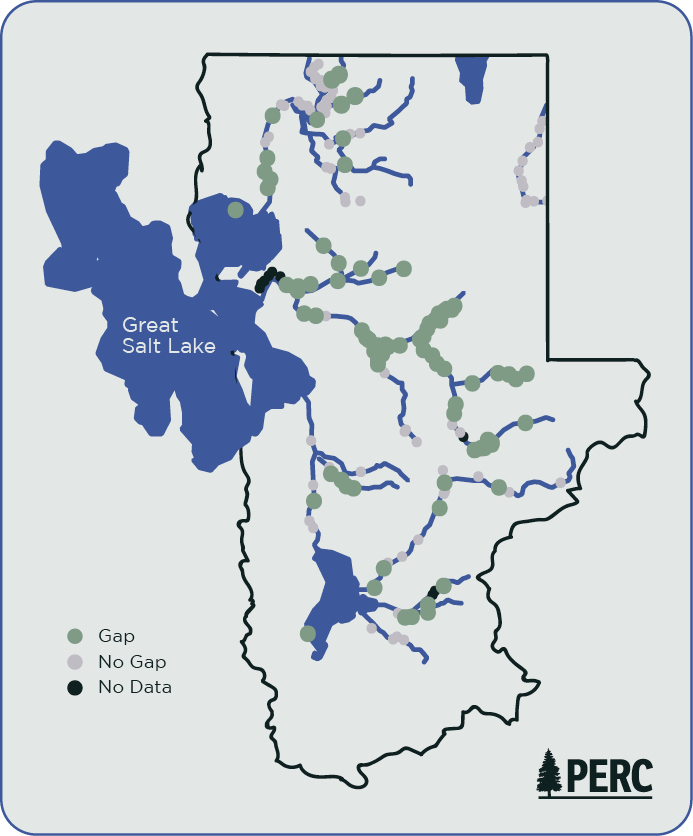
Legal and Institutional Obstacles
Utah’s water laws are rooted in the prior appropriation doctrine, a legal framework designed to allocate scarce water in an arid environment. The doctrine operates on the principle of “first in time, first in right,” meaning that older (senior) water rights take precedence over newer (junior) rights during times of scarcity. While this system can provide certainty to water rights holders, it can sometimes create obstacles to allocating water for environmental purposes, such as restoring flows to the Great Salt Lake.
One important challenge is the process of changing the legal use associated with a water right. Under current law, any modification to a water right—such as converting it from agricultural use to environmental flow—requires a change-of-use application that quantifies the amount of water that will be “changed.” This application must be approved by the state engineer, who must ensure that the change does not impact the rights of other water rights holders and that the method of quantification is reliable and reasonable.12Prior appropriation allocates water to those first in time, but that does not necessarily mean first in line. In other words, the doctrine does not allocate water based on location, a reality that can increase the cost to transfer water. Transferring water often affects the timing and amount of water other rights holders receive and can trigger objections from other users, which can increase the cost of a transfer. Without a baseline, the process can be time-consuming and costly, which deters many farmers from participating in water leasing, particularly for short-term arrangements such as split-season leases.
In addition, the traditional “use it or lose it” rule further complicates water leasing for instream purposes. Historically, the requirement that water must be put to narrowly defined “beneficial uses” discouraged conservation and left little incentive for farmers to adopt efficient irrigation methods or leave water in streams. Although recent legislative reforms in Utah have mitigated some of these disincentives, lingering fears about forfeiture and loss of rights continue to create hesitation among water rights holders.13Larson, Leia. 2023. “Farmers Are Skeptical about Participating in Water Leasing to Save the Great Salt Lake. Here’s Why.” The Salt Lake Tribune. (October 10, 2024); Larsen, Leia. “Farmers Have yet to Lease Water to Help the Great Salt Lake. Here’s What They Have to Say.” The Salt Lake Tribune. (October 10, 2024).
Another legal obstacle is the fragmentation of water rights across multiple administrative entities. In many cases, water rights are managed by irrigation districts or canal companies, which have their own bylaws and governance structures. Even if an individual farmer is willing to lease water for environmental purposes, district policies may restrict or complicate such transfers. This fragmentation requires coordinated efforts and negotiations to ensure that water-leasing agreements are feasible and effective.14Andrew B. Ayres and Daniel Bigelow. “Engaging Irrigation Districts in Water Markets.” In The Future of Water Markets: Obstacles and Opportunities; Edwards, E., Regan, S., eds.; Property and Environment Research Center (PERC): 2022.
Hydrological Uncertainty
Hydrological uncertainty poses another major challenge for water leasing programs. Even when water savings are achieved on a farm, there is no guarantee that the water will make it to the Great Salt Lake. The path from the farm to the lake is fraught with potential obstacles, including dry riverbeds, seepage losses, and diversions by downstream users. The variability of water availability, driven by changing climate conditions, adds another layer of complexity. During drought years, for instance, even senior water rights may not receive their full “paper water” allocation, complicating leasing agreements that rely on consistent water availability.
This uncertainty has led to concerns about shepherding, the process of protecting and managing leased water as it travels to its destination. Ensuring that leased water reaches the lake requires active management and coordination among multiple entities, including dam operators, canal companies, and state water agencies. Timing is also crucial; water released at certain times or under unfavorable conditions may never make it to the lake, rendering the lease ineffective. Addressing these hydrological challenges will require a combination of real-time water management, adaptive strategies, and investments in infrastructure.
Social and Economic Considerations
The social and economic impacts of water leasing also cannot be overlooked. Many farmers are understandably cautious about participating in water leasing programs, as their livelihoods depend on reliable water access. While compensation can make up for lost revenue, there are concerns about the long-term viability of farming operations and rural agricultural communities if water leasing becomes widespread.15Dilling, Lisa, John Berggren, Jennifer Henderson, and Douglas Kenney. 2019. “Savior of Rural Landscapes or Solomon’s Choice? Colorado’s Experiment with Alternative Transfer Methods for Water (ATMs).” Water Security 6: 100027. doi:10.1016/j.wasec.2019.100027.
Farmers also worry about the potential for permanent changes to water rights. Even though recent legislative reforms have reduced the risk of forfeiture, there is still anxiety about how participation in leasing programs might affect future water access. Given the extensive changes Utah has made to water law, some water rights holders may not be familiar with new options available to them. For example, for decades, rights holders who leased water for instream flow lost their historic priority. Now, thanks to legislative updates, instream flow leases can be temporary, and rights holders retain their priority—but these facts may not be well known. Building trust and raising awareness about these new opportunities will be essential for the success of these programs.
Conservation groups and state agencies must work closely with farmers to design flexible, fair, and transparent agreements that account for the economic realities of farming and the needs of rural communities.16Ostrom, Elinor. 1990. Governing the Commons: The Evolution of Institutions for Collective Action. Cambridge; New York: Cambridge University Press. Creative solutions, such as split-season leasing, can provide farmers with options that minimize economic impacts while contributing to lake restoration (see Box 3). Alfalfa, for instance, is a resilient crop that can be temporarily dewatered or irrigated less intensively without severe long-term consequences. Highlighting these opportunities and ensuring that farmers are aware of new, more flexible options can help foster a collaborative approach to Great Salt Lake restoration.
Box 3
Farmers are the Key to Conservation
A point of controversy in water leasing is that farms are often seen as the primary source of potential water reductions as opposed to cities. Cities hold few water rights for large volumes of water, making them seem like prime candidates to contribute to conservation. It is often relatively expensive and technologically intensive, however, to reduce water use within cities. Many cities already employ various conservation strategies, which is why it can be incredibly expensive to achieve even small additional water savings. Often taxpayers bear the brunt of the cost of additional savings, paying the highest price to conserve water.
On the other hand, farmers and agricultural operations generally hold many water rights that collectively account for almost all water that is consumptively used. This means that there are many more opportunities to partner with farmers and optimize irrigation in ways that allow them to continue farming while selling their saved water. When such partnerships occur, farms capture all of the benefits of conservation and are rewarded for those savings. In fact, several analyses have found that farms can decrease water use without compromising yields or profit.17Marston, Landon, Gambhir Lamsal, Zachary H Ancona, Peter Caldwell, Brian D Richter, Benjamin L Ruddell, Richard R Rushforth, and Kyle Frankel Davis. 2020. “Reducing Water Scarcity by Improving Water Productivity in the United States.” Environmental Research Letters 15(9): 094033. doi:10.1088/1748-9326/ab9d39; Richter, Brian D., Yufei Ao, Gambhir Lamsal, Dongyang Wei, Maria Amaya, Landon Marston, and Kyle Frankel Davis. 2023. “Alleviating Water Scarcity by Optimizing Crop Mixes.” Nature Water 1(12): 1035–47. doi:10.1038/s44221-023-00155-9. This is not to say that the agricultural sector is the only opportunity for water savings, as many cities may also decrease use over time. But the Great Salt Lake will not be saved without collaboration with farmers—they are the key to conservation.
Key Considerations to Make Leasing Effective
Effective water leasing will require careful consideration of farmers’ concerns as well as the likelihood that a lease will increase inflows to the Great Salt Lake. While water leasing can be used for more than conservation, this report aims to explore factors that can facilitate leases that leave farms and the lake better off. The following considerations must be taken into account to help achieve that goal.
1. Prioritize water rights that are likely to bolster the lake.
Lessees should prioritize water rights from which water savings can be measured and water has the highest likelihood of reaching the lake. Much of this prioritization depends on the ability to estimate historical wet water use and monitor water savings.
- Leverage satellite data, like evapotranspiration, to establish a benchmark for historical wet water use as a method for measuring water savings. Evapotranspiration (ET) can be used as a benchmark for expected water savings and provide farms with relevant information for leasing or farm operations. States such as Oregon and Washington already consider ET in the evaluation of consumptive use, unless water rights holders can prove historical use through personal monitoring. It is not necessary for the state to use ET to enforce current water use, especially if the goal is to increase lake levels. In Utah, this approach could focus on establishing a baseline for consumptive use to measure water savings. Regardless of how much water a farmer is currently consuming, the reality is that the Great Salt Lake needs additional water—thus, all that is needed to determine water savings is a benchmark for consumptive use. The goal should be to understand trends in water use relative to a baseline rather than exact magnitudes of consumption. ET data can provide these baseline estimates at a field-by-field level.
- Exploit wet years by contracting with junior water rights holders. Contracting with junior water rights holders might be risky for long-term leases, as they are less likely than senior rights holders to receive their full paper water allotments. But wet years provide a surplus of water that could be leased for the lake, presenting an opportunity for short-term leases with junior users that could boost lake levels. A farm holding junior water rights may be accustomed to receiving less than its full paper water allotment, meaning it’s adapted operations to cope with a lower wet water amount. In wet years, such a farm would receive its full paper allotment, providing a potential opportunity to lease that “wet year surplus” for the lake.
- Minimize uncertainty in long-term leases by evaluating stable water right characteristics. When structuring multi-year leases, it is important to focus on water rights with stable and predictable characteristics. For instance, senior water rights located closer to the lake typically involve less uncertainty than junior rights farther away. Additionally, water rights within irrigation districts may face more obstacles to transfers than those outside of them. To make long-term leases effective, decision makers should aim to reduce uncertainty by carefully considering these key characteristics.
- Build diversified water lease portfolios. While minimizing uncertainty through stable water rights is important for long-term leases, lessees should also consider managing water rights as part of a diversified portfolio. For example, purchasing a mix of senior and junior water rights can optimize costs while ensuring reliable water availability. Junior water rights, which are typically less expensive, may provide valuable contributions in wet years, complementing the stability offered by senior rights. A diversified portfolio allows decision makers to optimize costs and ensure water availability over the long term. Water managers should identify a ten-year “return” of water to the Great Salt Lake and ensure that each lease and acquisition balance the risk and return relative to that ten-year goal. This management approach could provide clarity on when to purchase or lease water for lake restoration.
2. Modernize water rights data for effective decision-making.
Water rights datasets should not be limited to legal records, especially as the focus shifts toward identifying water leasing opportunities. Updating and enhancing water rights data can improve leasing decisions and make programs more effective.
- Ensure existing information is up to date and identify gaps for leasing. State agencies often maintain records with different goals, which can lead to gaps in data critical for leasing decisions. Existing records should be reviewed and updated to reflect necessary details, such as priority status, place of use, and water amounts. Compiling additional data, such as annual consumptive use estimates and connections between water rights, should be prioritized.
- Invest in program evaluations to estimate water savings. To address data gaps, there is a need to fund evaluations that estimate water savings. For example, studies could measure the impact of agricultural optimization projects on consumptive use. Collaborating with economists, hydrologists, and other researchers interested in these methods could generate valuable insights while minimizing the financial burden on state agencies.
- Determine shepherding “thresholds.” While uncertainty in water transfers is inevitable, better information can reduce uncertainty. Lessees may find it advantageous to understand “shepherding thresholds” as leasing progresses. For example, how many downstream users is too many? How much “carryover” water is needed to ensure water makes it to the lake?18Carryover water describes the amount of water necessary in a canal to ensure that water can move through it rather than being absorbed by it. What types of diverters typically object to a transfer? Answering these questions may identify critical thresholds for shepherding concerns.
3. Design contracts to address relevant uncertainty for both parties.
Both farmers and lessees face uncertainties in water leasing agreements. Farmers are concerned about the trade-offs between water savings and crop production, while lessees worry about whether the saved water will meaningfully increase lake levels.19This is generally known as the principal-agent problem. In this case, the principal is the lessee, and the agent is the farmer. Because there is uncertainty over how to generate water savings, mainly in how much is generated, economic theory suggests creating a contract over water savings, the output. This contract, known as a coarse contract, is over the output, not the inputs, such as the crop being grown. See Cheung, Steven N. S. 1983. “The Contractual Nature of the Firm.” The Journal of Law and Economics 26(1): 1–21. doi:10.1086/467023; Burkett, Justin, and Maxwell Rosenthal. 2024. “Statistical Uncertainty and Coarse Contracts.” Journal of Economic Theory 220: 105876. doi:10.1016/j.jet.2024.105876. Other examples of the benefits of coarse contracts can be found in fisheries. See Wilen, James E. 2006. “Why Fisheries Management Fails: Treating Symptoms Rather than the Cause.” Bulletin of Marine Science 78(3): 529–46; and Birkenbach, Anna M., David J. Kaczan, and Martin D. Smith. 2017. “Catch Shares Slow the Race to Fish.” Nature 544(7649): 223–26. doi:10.1038/nature21728. Contracts should be designed to mitigate these concerns.
- Link payments to water savings, not specific practices. Contracts should compensate farmers based on actual water savings rather than the implementation of specific technologies. This approach gives farmers flexibility to choose the best conservation methods for their operations. By using ET data as a baseline, lessees can measure real water savings and structure payments accordingly. In other words, as water savings are realized and measured, farmers can be paid for those real savings, rather than for making changes that would theoretically result in savings. If farmers incur costs to implement agricultural-optimization projects, lessees could receive a one-time payment for enrolling in the program. Then after enrollment, lessees could receive annual payments for water savings. Program enrollment could require that water savings be leased to the lake, but farmers could opt out at any time. Depending on drought conditions, farmers could choose the water conservation method that makes the most sense for them, and they would not be bound to costly technology that may not be in their best interest.
- Suspend forfeiture risk for leases to the Great Salt Lake. To encourage participation, consider suspending forfeiture risk for water leased to the Great Salt Lake. While it is not practical to eliminate forfeiture of unused water entirely, to expedite leasing for the Great Salt Lake, policymakers could consider allowing the state engineer to overlook forfeiture for such leases. Some farms may not want their water rights to be scrutinized, so the state should allow contracts to be made in terms of historical wet water while agreeing not to diminish water rights under traditional forfeiture rules. Instead, leases should include clauses that wet water use will be monitored and may not increase beyond the historical amount during the period of leasing for lake restoration. If suspending forfeiture for all leases aimed at lake-restoration is not possible, then the state should consider automatically enrolling such “forfeited” water as water protected for restoration efforts and compensate rights holders for it at a discounted price.
- Tailor contracts to address local concerns. Farmers rightly express hesitation about fallowing land, the effect of leasing on local economies, and the risk of agricultural land being sold to development. Contract writers should meet with local communities to establish Memorandums of Understanding (MOUs) with districts that protect against those concerns but also tailor leases to reflect individual farm concerns. For example, district MOUs might specify that a certain percentage of the district must remain in use, while a particular voluntary contract might obligate a farmer to produce water savings. In either case, communities should dictate these limitations to reflect local preferences.20This criteria is based on Elinor Ostrom’s design principles for successful common pool resource management. Design principles three and eight highlight the importance of including resource users in the rule-making process, and allowing rules over individuals (those leasing water) to be different from the rules over those in the district (those who lease water and those who do not lease water). Incorporating both preferences ensures longevity and compliance with programs. Ostrom, Elinor. 1990. Governing the Commons: The Evolution of Institutions for Collective Action. Cambridge; New York: Cambridge University Press.
4. Conduct basin-level analysis to reform lease evaluation and identify potential leasing opportunities.
While evaluating leases on a water-right-by-water-right basis is essential, incorporating basin-level analysis can enhance the overall effectiveness of leasing strategies.
- Produce a “state of the union” on basin-level water use, tailored toward lake restoration. Many departments produce annual reports on crop production, yields, and prices. While this information is important, additional information could be generated on the nexus of food production and water use at the basin level. Producing a document that helps decision makers understand where and how water is being used may help identify potential areas for water conservation. The Farm Bureau and other agricultural organizations could help by providing insight into the trade-offs of water conservation for lake restoration.
- Research other major water transfer efforts and highlight their successes and challenges. Saline lakes are difficult, but not impossible, to save. Those working on the front lines need additional information that helps build a better understanding of the challenges to expect, the length of time needed to produce results, and how to identify successes as they occur. Studying other major water transfer projects, such as the Colorado-Big Thompson Project, can offer lessons on overcoming challenges and achieving results. This research should also provide information to farmers about how water transfers can be expected to impact crop prices, local economies, and drought tolerance.
5. Develop a water leasing pilot project area in a key basin.
To more fully understand the barriers and opportunities for voluntary water leasing, conservation groups should partner with agricultural communities to develop pilot projects. Using the criteria above and new data, a group could identify areas most practical for early leases and work with farmers in those areas, such as the Bear River Basin. By completing an on-the-ground transfer, stakeholders can gain insights into the real-world challenges of leasing and refine strategies for future success.

Doing the Impossible
No country has been able to save a saline lake. The task itself may look impossible, but we choose to do great things not because they are easy, but because they are hard. Utah has done many seemingly impossible things when it comes to water policy. The state has pioneered some of the most innovative water leasing policies in the West. Now, the state has a chance to once again do something that no other state has done before. If Utah succeeds, it will not simply save a saline lake, but through cooperation and collaboration, its people will have saved the greatest saline lake—the Great Salt Lake.
As water scarcity, changes in climate variability, and competing demands intensify, how we choose to respond will make all the difference. Voluntary water leasing offers a flexible and durable path forward, one that balances restoration efforts with the needs of existing water users—and without penalizing their preferences. This method not only provides a win-win for conservationists and farmers, but it also offers the flexibility necessary for farmers to adapt to weather variability in the long run. By addressing the legal, hydrological, social, and technical challenges with determined optimism, Utah can once again lead the way in environmental management—and perhaps do the “impossible” by saving the Great Salt Lake.



